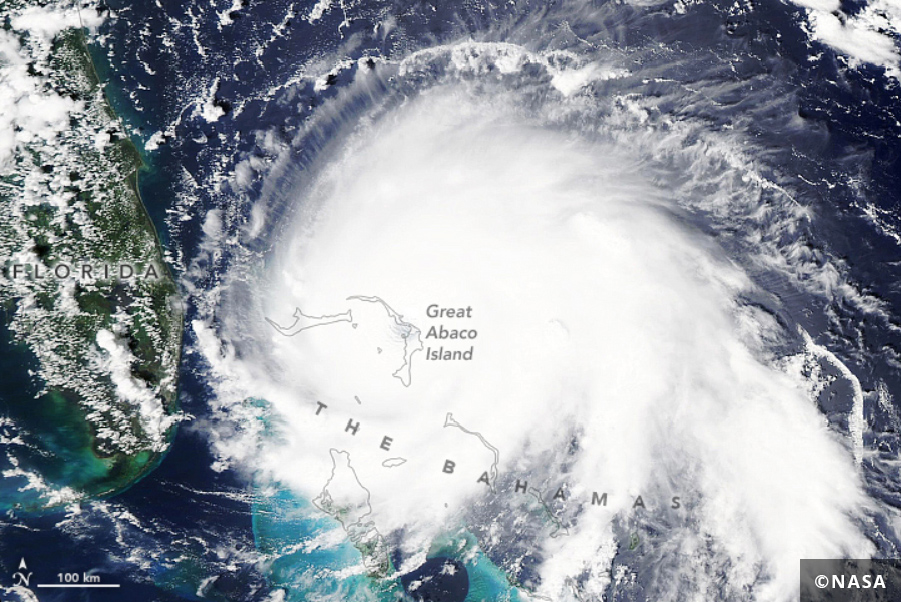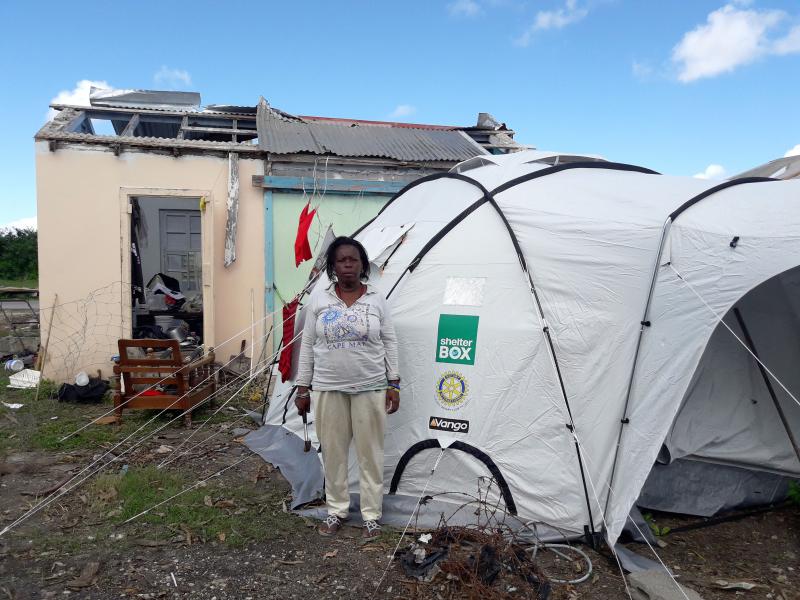THE DESTRUCTIVE PATH OF HURRICANE DORIAN
Hurricane Dorian made landfall in the Northern Bahamas as a category 5 storm. The storm crept across the Abaco Islands on Sunday and stalled over Grand Bahama Island for 24 hours, veering North on Tuesday morning.
The destruction caused by the storm’s slow pace is immense, as buildings are exposed to these devastating winds, rains, and storm surges for hours.
Early reports suggest over 13,000 homes have been damaged so far. Hurricane Dorian is now tied for the second strongest hurricane on record in the Atlantic, the last being a hurricane from 1935 before hurricanes were even named.
A ShelterBox team arrived in the Bahamas September 7th, with the aim to speak to our local contacts and other organizations to assess the extent of the damage and whether we may assist.
We need to fully assess the situation to understand whether our emergency items such as tents, tarpaulins and solar lights will be needed and appropriate for families in the Bahamas. We have aid propositioned in Panama should a response be appropriate. We will continue to work closely with local Rotarian’s and Rotary Clubs to gather localized information and support.
It is important to ShelterBox that we take time in this phase to better understand the situation and the ground and ensure that families receive the type of support they need most. This means that your generous donations always have the greatest impact for families around the world.

KEY FACTS: HURRICANE DORIAN AND THE 2019 HURRICANE SEASON
Dorian is the fourth named storm of the 2019 hurricane season, which runs from June 1 to November 30.
The low-pressure system that became Dorian formed on August 23, strengthened to a tropical storm on August 24 and became a hurricane on August 28.
Near-normal tropical storm activity is predicted for the Atlantic Ocean in 2019, according to NOAA, the National Oceanic and Atmospheric Administration.
In an average season, there are 12 named storms, including six hurricanes, with about half of them being major hurricanes with winds of 111 mph or greater.
In past years over 80% of hurricane season activity has occurred during the two-month stretch from August 20th to October 20th. Although we have only seen two named hurricanes so far in the 2019 hurricane season, this doesn’t mean that it will be a quieter season.
Each year, Colorado State University’s (CSU) Tropical Meteorology Project issues an updated outlook in order to account for the various summer changes. In their most recent outlook (as of August 05 2019) they predict 14 named storms, seven hurricanes and two major hurricanes.
HOW DOES SHELTERBOX MONITOR HURRICANES?
When we’re monitoring a tropical storm, we use a variety of sources to give us a detailed overview of the situation.
Windy – this lets us see current weather updates and weather patterns for the next 7/8 days. We can normally identify ahead of time when it looks like a tropical storm / hurricane will start to form, and we can then monitor the storm accordingly.
GDACS – The Global Disaster Alert and Coordination System is a resource that provides updates on a range of disaster events which rates the overall humanitarian impact of a disaster, and provides updates on the impact of the disaster, as well as resources such as maps of the affected areas.
Automated Disaster Analysis and Mapping (ADAM) – an interactive map that tracks active tropical storms and earthquakes.
National Hurricane Centre – a website operated by the National Oceanic and Atmospheric Administration (NOAA) that issues updates and key messaging on tropical storms and hurricanes. They also produce detailed maps and issue advisories for areas where a tropical storm or hurricane is expected to make landfall.
National Oceanic and Atmospheric Administration (NOAA) – A US government agency, that issues a forecast for the hurricane season.
Depending on where a storm is predicted to make landfall, we will often monitor local news sources and government and disaster management agency websites, to understand how governments and local agencies are preparing for and responding to the storm.
We continue to monitor the situation after the storm has made landfall to understand the impact on affected communities, and to see if there will be an emergency shelter need.
We use our response criteria to make the decision around whether or not we are in a position to respond.
HOW DOES SHELTERBOX HELP HURRICANE-STRICKEN COMMUNITIES?

Dealing with the aftermath of a hurricane or typhoon can be very challenging. Whole communities can be destroyed, from people’s homes to vital infrastructure such as roads, communication lines, power and medical supplies.
Despite the challenges, we often respond to places that are hit by tropical storms. After hurricane Irma and Maria wreaked havoc in 2017, we have provided essential aid to over 2,000 families across five islands in the Caribbean. See how we’ve supported families.
By providing emergency shelter, people can have somewhere warm to stay and feel safe, which makes the process of recovery a whole lot easier.
It has made a big difference to have a tent. It protects me from the rain. I love my tent.
– Amy, Barbuda
